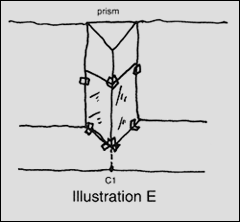 |


|
Lesson 4 Activity 1: Mapping the Third Dimension
Make a stereoscope. Great advances in mapping in the 20th century were based on the three-dimensional image visible in the stereoscope. In this activity, students work in pairs to construct a simple stereoscope. A pair of stereo photographs is included to use to view a three-dimensional image.
Time
One 50-minute period for step 1.
30 minutes for remainder of the activity.
Materials for each pair of students
- One cardboard box (an empty copier box works nicely)
- Knife for cutting the box
- Two locker mirrors (durable, light weight, about 4 by 5 inches)
- Ruler
- Transparent Tape
- Overlapping (stereo) aerial photos (enclosed)
Procedures

- Make the stereoscope as follows.
- Remove the top of the box, leaving the box at least six inches deep.
- Cut the box in half along the longer dimension (see illustration A) and set one half aside.
- Place the half of the box (let's call this the "frame") in front of you so that you are looking into it. Along the back and front edges of the bottom panel, measure half the distance between the left (L) and right (R) end panels. Mark these points C1 and C2 and connect them with a line (see illustration B.) Measure the height of the back panel of the frame (H). Set the frame aside temporarily.


- Using another piece of the original box, cut a prism-shaped piece that has a 90-degree angle (see illustration C). The two sides (S) of the prism that meet at the 90-degree angle must be the same size, one inch wider than the locker mirrors. The long dimension of the prism need not be longer than the value H.
- Attach the prism to the frame (see illustration D). Orient the prism so that the edge with the 90-degree angle is on the center line (C1-C2) and is pointed at the open side of the frame. The sides of the prism should be against the back panel of the frame, and the distance (D) between the sides of the prism and the end panels should be equal.

- Tape the mirrors to the prism, resting them on the bottom panel of the frame, as shown in illustration E. Mirrors should meet at the 90-degree angle. This completes the stereoscope.

- Using paper clips, attach the enclosed stereo photographs to the ends of the box, being careful to position them so that the right eye sees the area of overlap in the right mirror and the left eye sees it in the left mirror.

- Position the stereoscope so that both photographs are illuminated equally.
- Look straight at the near edge of the mirrors from about a foot away (see illustration F). Tips for seeing the three-dimensional image: As you look for the stereoimage, try closing first one eye and then the other. Choose a distinctive feature and find it on both photographs. As you look, keep one image fixed and move the other image slightly to make the images of a distinctive feature on the two photographs come together. The three-dimensional image of the whole scene may suddenly appear (and perhaps, disappear). Once you see the stereoimage, it is generally easier to see it again.
- As a class, discuss how your brain constructs a three-dimensional from the two, two-dimensional air photos. Photographs are taken sequentially along a flightline so that adjacent photographs overlap by about 60 percent. The left photo shows the perspective from the left camera station, and the right photo shows the perspective from the right camera station. Thus, your left eye sees the image from a different perspective from the right eye. The brain fuses the two images so that you see the entire area of overlap in three dimensions.
- In this exercise, the three-dimensional image in your brain exaggerates the vertical relief; the slopes look steeper and buildings look taller on the stereo image than they are. This vertical exaggeration is a function of the geometry of the camera and the altitude of the camera when the photographs were taken. Vertical exaggeration, which can be useful in topographic mapping, can be quantified (or even eliminated) by photogrammetric mapping instruments. Judging by the vertical relief in the stereo image you see, sketch a topographic map of the area of overlap; select a contour interval and make the map at the same size as the stereo image.

|
Intro & Lessons |
Teacher's Guide |
Explorers
|
|
|
 |
|